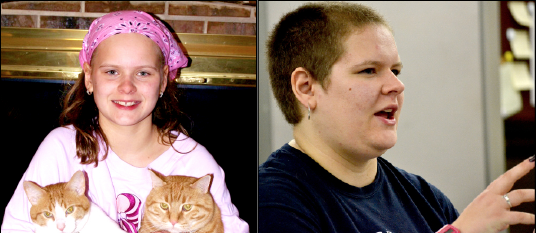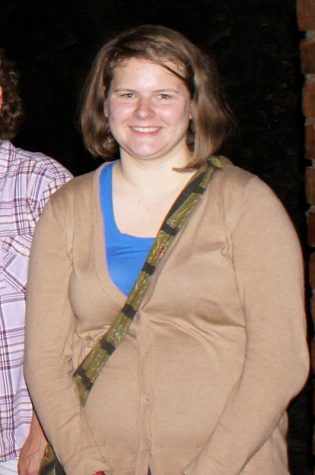I’m a Trich-ster

Erin Thompson in 2008 wearing bandana to hide pulling spots and Thompson in 2016 with shaven head
May 4, 2016
Erin Thompson walks through the halls of COD proudly with a freshly shaven head. Her tall stature holds her head high with a spunky attitude, though her shaven head represents years of battle against herself.
The battle is something unknown to the majority of the community. Erin has trichotillomania and dermatillomania.
Trichotillomania or “trich” is a neurobiological disorder that has no cure or deep understanding yet. In short, it’s a disorder that causes people to pull out their hair, whether it be eyelashes, eyebrows or head hair. Dermatillomania is the pulling of skin.
Thompson has been pulling her hair since she was in fourth grade. Her elementary years are plagued by the memories of bandana after bandana hiding her bald spots from family and peers.
Her pulling had gotten to a point in her later years where she needed a hairpiece to cover her spots. Her “hot spot,” or place where she pulled the most, was the crown of her head. Thompson pulls hair and eats the follicles. The anxiety is why Thompson decided to shave her head.

The difference between having a simple habit of pulling hair or picking at your skin is the fact that those who suffer from these disorders have it take up huge amounts of time.
“Body focused repetitive behavior are those things focused around the body,” said Thompson. “Some people will do self-grooming like tweeze their brows, pop pimples. There’s a difference between that and spending up to an hour or more in the bathroom looking in the mirror picking and sitting in the car picking.”
According to the Trichotillomania Learning Center (TLC), two in 50 people suffer from
Trich, though Thompson finds not enough people know about it. Thompson finds support in friends, family and those she has met through TLC’s annual conferences, which brings others who have trich together.
“So many people feel horrible about their Trichotillomania,” said Thompson. “When I see kids running around with patches of hair at the conference, I feel so bad. I started when I was 7 or 8, but there are kids there as young as second grade.”
In the beginning, Thompson’s Trich wasn’t caused by anxiety, but as she grew older, her trich became worsened by her ongoing struggles with depression. Her depression was worsened but also caused by Trich. She fights an ongoing battle with herself every day.
Oftentimes, those who pull can go into a “trance” where they don’t even remember pulling chunks of their own hair out. For Thompson, she doesn’t even feel it when she pulls. If anything, it feels good.
“So many people may have trich or not know what it is,” said Thompson. “So many people feel like they’re alone, and I want them to know they are not, and there is help out there. There’s a lot of people who have it. I want to get a community together and start connections and a group to hang out.”
Thompson knows too many stories of those unaware of the disorder, from hairdressers to teachers to family members.
“I want there to be a world where people know where it is,” said Thompson. “A woman has compared it to eating disorders 20 years ago. People were very hushed hushed about it and didn’t talk much about it. Now, everybody is open with it. Right now, not many people know about [Trich], and people hide it. I want it to be one of those things where they hear the word, they know what it is, and they don’t judge the people for it, and they know it’s okay.”
To reach out to Thompson for questions or help, email her at [email protected].




















Lauren • May 4, 2016 at 9:45 am
This was a great article to read. It’s so amazing for Erin to share her story in order to spread awareness and help those in her community that are impacted by BFRBs. You have such spirit and courage, thank you Erin!!